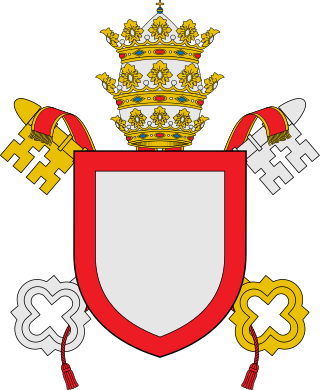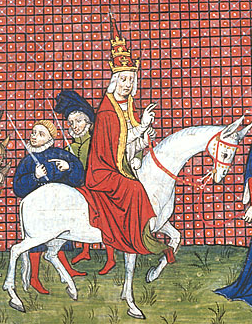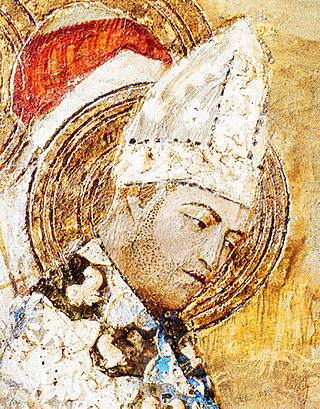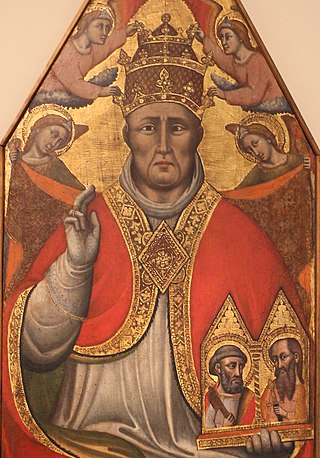
Pope Benedict XII, born Jacques Fournier, was head of the Catholic Church from 30 December 1334 to his death, in April 1342. He was the third Avignon pope and reformed monastic orders and opposed nepotism. Unable to remove his capital to Rome or Bologna, Benedict started the great palace at Avignon. He settled the beatific vision controversy of Pope John XXII with the bull Benedictus Deus, which stated that souls may attain the "fullness of the beatific vision" before the Last Judgment. Despite many diplomatic attempts with Emperor Louis IV to resolve their differences, Benedict failed to bring the Holy Roman Empire back under papal dominance. He died 25 April 1342 and was buried in Avignon.

Pope Gregory XI was head of the Catholic Church from 30 December 1370 to his death, in March 1378. He was the seventh and last Avignon pope and the most recent French pope recognized by the modern Catholic Church. In 1377, Gregory XI returned the Papal court to Rome, ending nearly 70 years of papal residency in Avignon, France. His death was swiftly followed by the Western Schism involving two Avignon-based antipopes.

Pope John XXII, born Jacques Duèze, was head of the Catholic Church from 7 August 1316 to his death, in December 1334. He was the second and longest-reigning Avignon Pope, elected by the Conclave of Cardinals, which was assembled in Lyon. Like his predecessor, Clement V, Pope John centralized power and income in the Papacy and lived a princely life in Avignon.

The Avignon Papacy was the period from 1309 to 1376 during which seven successive popes resided in Avignon rather than in Rome. The situation arose from the conflict between the papacy and the French crown, culminating in the death of Pope Boniface VIII after his arrest and maltreatment by Philip IV of France. Following the subsequent death of Pope Benedict XI, Philip forced a deadlocked conclave to elect the French Clement V as pope in 1305. Clement refused to move to Rome, and in 1309 he moved his court to the papal enclave at Avignon, where it remained for the next 67 years. This absence from Rome is sometimes referred to as the "Babylonian captivity of the Papacy".

A money changer is a person or organization whose business is the exchange of coins or currency of one country for that of another. This trade was a predecessor of modern banking.
A discretionary deposit is the term given to a device by medieval European bankers as a method of circumventing Catholic canon law edicts prohibiting the sin of usury. At the time, most Christian nations heavily incorporated Biblical scripture into their laws, and as such it was illegal for any person to charge interest on a loan of money.

The Medici Bank was a financial institution created by the Medici family in Italy during the 15th century (1397–1494). It was the largest and most respected bank in Europe during its prime. There are some estimates that the Medici family was, for a period of time, the wealthiest family in Europe. Estimating their wealth in today's money is difficult and imprecise, considering that they owned art, land, and gold. With this monetary wealth, the family acquired political power initially in Florence, and later in the wider spheres of Italy and Europe.

Francesco Sassetti was an Italian banker.
Vix pervenit is an encyclical, promulgated by Pope Benedict XIV on November 1, 1745, which condemned the practice of charging interest on loans as usury. Because the encyclical was addressed to the bishops of Italy, it is generally not considered ex cathedra. The Holy Office applied the encyclical to the whole of the Roman Catholic Church on July 29, 1836, during the reign of Pope Gregory XVI.

The papal conclave held from 5 to 7 May 1342 was convened after the death of Pope Benedict XII and elected Cardinal Pierre Roger to succeed as pope. The fourth pope of the period of the Avignon Papacy, he took the name Clement VI.

Pierre Desprès (1288–1361) was a French Cardinal during the period of the Avignon Papacy.
Guido Terrena, also known as Guido Terreni and Guy de Perpignan, was a Catalan Carmelite canon lawyer and scholastic philosopher.

The papal conclave held from 1 May 1314 to 7 August 1316 in the apostolic palace of Carpentras and then the Dominican house in Lyon was one of the longest conclaves in the history of the Roman Catholic Church and the first conclave of the Avignon Papacy. The length of the conclave was due to the division of the cardinals into three factions: Italian, Gascon, and French/Provençal.

During the Middle Ages, the Gran Tavola was the largest Sienese bank; it was one of the most powerful banks in Europe from 1255 to 1298. The Gran Tavola has been called "the greatest bank of the thirteenth century" as well as "one of the largest commercial and banking enterprises in Europe".

Bertrand du Pouget was a French papal diplomat and Cardinal.

Napoleone Orsini was a Roman cardinal. His ecclesiastical career lasted 57 years, 54 of them as a cardinal, and included six conclaves.

A papal conclave was held between 22 September and 28 October 1362 in the Palais des Papes of Avignon to elect the successor of Pope Innocent VI. Guillaume de Grimoard was elected pope and took the name Urban V.
Raymond Adrien Marie de Roover (1904–1972) was an economic historian of medieval Europe, whose scholarship explained why Scholastic economic thought is best understood as a precursor of, and wholly compatible with, classical economic thought. In contrast, many mid-20th-century economic historians, such as R.H. Tawney, taught that Karl Marx was the last and greatest of the Scholastic economists.
Giovanni Colonna was a Roman Catholic cardinal during the Avignon papacy and was a scion of the famous Colonna family that played an important role in Italian history.

Bertrand de Déaulx was a French bishop, diplomat, and Cardinal. He was born, perhaps around 1290, in Castrum de Blandiaco in the diocese of Uzès; or in Déaulx. He died in Avignon in 1355. Trained as a lawyer and teacher of law, he practiced in the papal courts and became an arbitrator and diplomat for the Papacy. He had several assignments in Italy and one in Catalonia. He was responsible for the reorganization of the University of Montpellier and the granting of revised charters.














